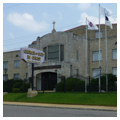You are here
Mason Temple, Church of God in Christ
The Church of God in Christ (COGIC) was founded in 1897 by Bishop Charles Harrison Mason (1866–1961). The son of former slaves in Shelby County, Tennessee, Mason was raised in the Missionary Baptist Church and became a preacher in the Mount Gale Missionary Baptist Church. In the mid-1890s Mason briefly attended Arkansas Bible College, but his unorthodox belief in personal sanctification—inspired by the teachings of Amanda Berry Smith, the African American Methodist evangelist—proved to be controversial. He left school and started preaching to congregations around Lexington, Mississippi. Expelled from Mississippi State Baptist Association in 1896, Mason joined Reverend Charles P. Jones in hosting revivals in an abandoned cotton gin in Lexington. Within a year, though, with some sixty converts, Mason incorporated the Church of God in Christ in Memphis. By 1907, COGIC had grown to include a dozen churches in Arkansas, Oklahoma, Mississippi and western Tennessee. In 1924 the denomination built its first National Temple in Memphis to serve as a meeting hall for annual convocations. During the convocation of December 8, 1936, the wood-framed temple, built to accommodate 5,000 people, caught fire and burned.
Four years later work began on the current temple, this one constructed of fire-resistant steel and masonry. With building materials in short supply during World War II, construction took the better part of five years. The architect for the Mason Temple was W. H. Taylor, an Elder in the church. Though Taylor’s name does not appear in the Memphis city directory and nothing is known about his training and practice, the temple’s design and engineering suggest that he was more than an amateur architect.
The main entrance, faced in finely dressed stone, retains some of its late Art Deco detailing, especially in the keystone-like ornamentation along the top of the hooded portal and the cornice. Buff-colored brick sheathes the symmetrical recessed wings on either side of the main entrance. Each wing, housing offices, includes eight large metal casement windows. Behind the entrance and its wings is an expansive auditorium, also faced in brick and topped with a red metal gambrel roof supported by steel trusses. The temple is approximately 134 by 200 feet and seats 7,500 people on two levels. A rostrum is located near the middle of the auditorium. It includes a pulpit, seating for Senior Bishops, and a baptistery. Some 250 people can be seated in this area, defined from the rest of the auditorium by a cast-concrete balustrade.
Mason Temple is best known as the place where Reverend Martin Luther King Jr. delivered his prophetic “I’ve Been to the Mountaintop” speech. The address was scheduled only at the last minute. On the evening of April 3, 1968 the temple was scheduled to host a speech by the Reverend Ralph Abernathy in conjunction with a meeting of the Southern Christian Leadership Conference. But when the crowd of 3,000 demanded to hear King, Abernathy phoned King at the Lorraine Hotel and invited him to address the assembly instead. King was in Memphis at the time to support a strike of 1,300 African American sanitation workers. He was assassinated at the Lorraine the following evening.
The temple is the most prominent structure in a complex of seven buildings and parking lots that occupy several large city blocks in a residential neighborhood south of downtown Memphis. In addition to the temple, the complex includes the Old Publishing House and Administration Building (1957–1958), Lela Mason Hall (built 1934 and remodeled in 1944), John Lee Hall (1943–1944), Bailey Guest House (c. 1960) and the C. H. Mason Residence (1958).
The Church of God in Christ still serves as headquarters of the largest Pentecostal denomination in the world, with eight million members organized into 15,000 congregations across more than sixty nations. Mason Temple is still the site of the annual assembly of its representatives, the International Holy Convocation. It also houses the tomb of Bishop Mason and serves as a powerful landmark in the history of the Civil Rights Movement. The building was designated as historical landmark in 1991, the year of its restoration.
References
Gordon, Melton, J. and Martin Baumann. Religions of the World: A Comprehensive Encyclopedia of Beliefs and Practices. 2nd ed. Santa Barbara, CA: ABC-CLIO, 2010.
Hopkins, John Linn, “Mason Temple, Church of God in Christ,” Shelby County, Tennessee. National Register of Historic Places Inventory-Nomination Form, 1991. National Park Service, U.S. Department of the Interior, Washington, DC.
National Park Service. “Mason Temple, Church of God in Christ.” National Park Service, U.S. Department of the Interior. Accessed July 28, 2016. http://www.nps.gov/nr/travel/civilrights/tn1.htm.
Writing Credits
If SAH Archipedia has been useful to you, please consider supporting it.
SAH Archipedia tells the story of the United States through its buildings, landscapes, and cities. This freely available resource empowers the public with authoritative knowledge that deepens their understanding and appreciation of the built environment. But the Society of Architectural Historians, which created SAH Archipedia with University of Virginia Press, needs your support to maintain the high-caliber research, writing, photography, cartography, editing, design, and programming that make SAH Archipedia a trusted online resource available to all who value the history of place, heritage tourism, and learning.



















